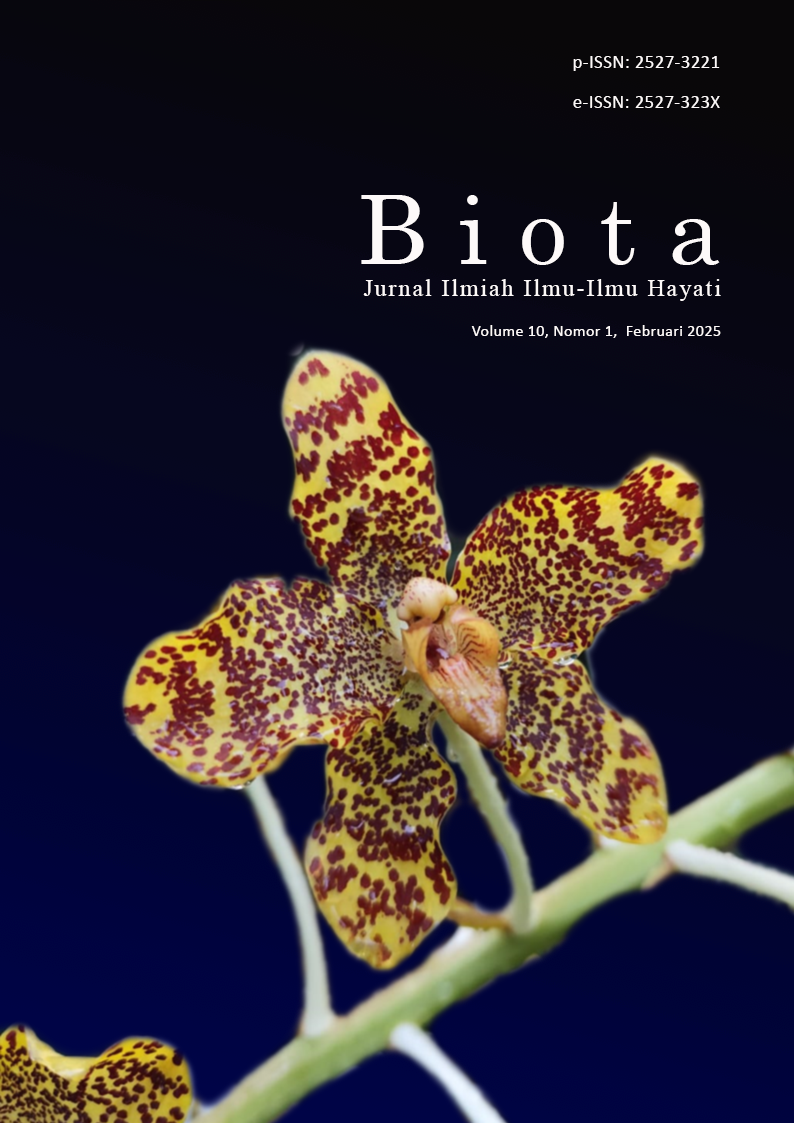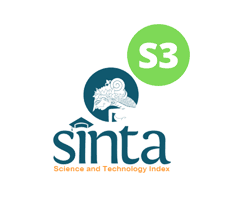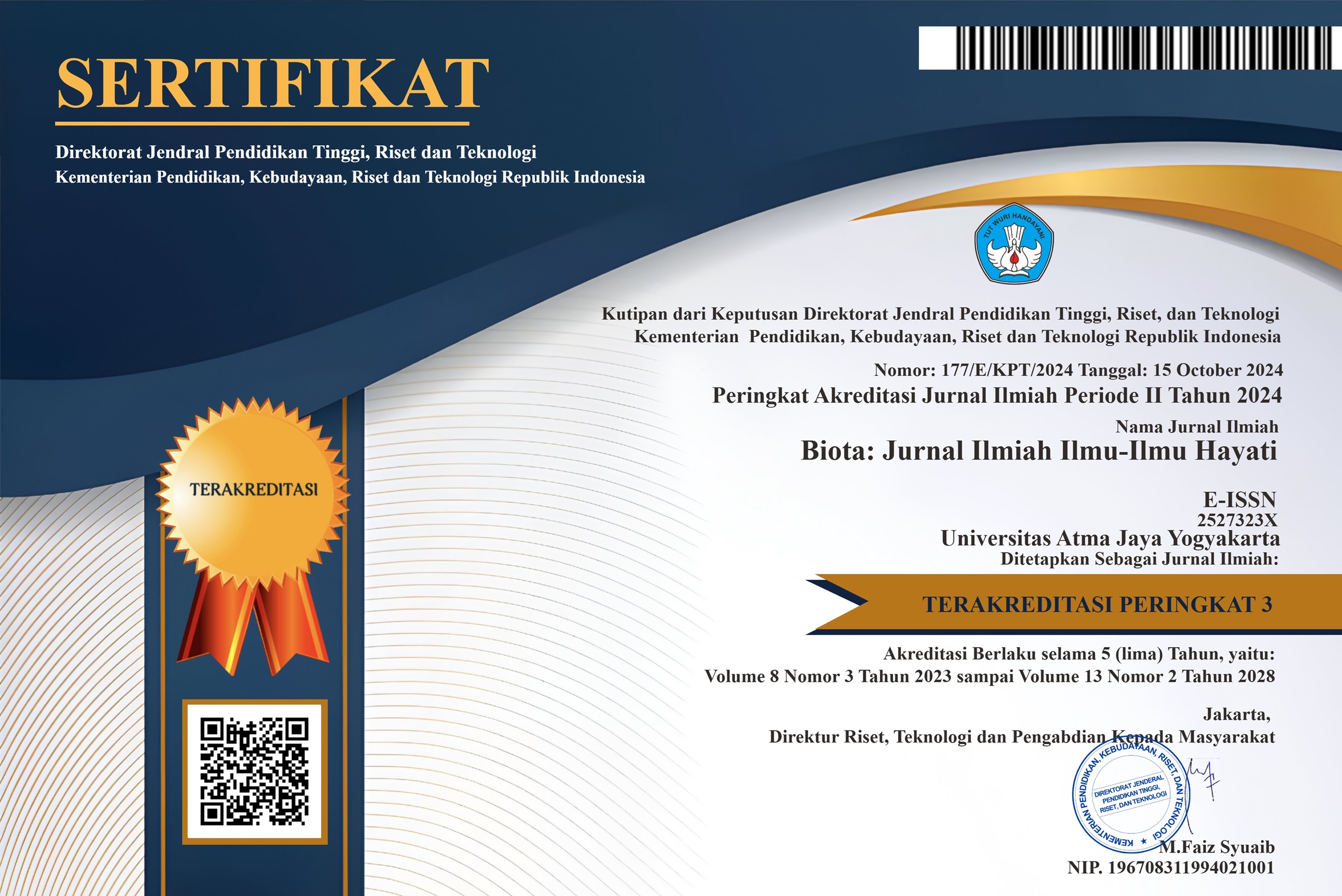Interaksi Molekuler Senyawa Kuersetin dan Eugenol terhadap Protein Regulator Lintasan Penuaan SIR2, pada Khamir Saccharomyces cerevisiae
DOI:
https://doi.org/10.24002/biota.v10i1.6819Keywords:
Antipenuaan, in silico, khamir, ligan-reseptorAbstract
Proses penuaan dapat dipengaruhi oleh beberapa faktor, seperti peningkatan cekaman oksidatif dan inflamasi di mana senyawa antioksidan seperti kuersetin dan eugenol dapat mengatasi hal tersebut. Kuersetin dan eugenol merupakan senyawa antioksidan yang dapat ditemukan di alam. Kuersetin dan eugenol memiliki aktivitas antioksidan pada sel khamir maupun sel mamalia. Namun, mekanisme kedua senyawa ini dalam meregulasi penuaan di level molekuler belum tersedia. Oleh karena itu, penelitian ini dilakukan dengan tujuan untuk mengetahui interaksi senyawa kuersetin dan eugenol pada protein Sir2 pada Saccharomyces cerevisiae yang memiliki peran sebagai regulator sistem penuaan. Penelitian menggunakan studi penambatan molekular dengan senyawa kuersetin dan eugenol sebagai ligan uji, sedangkan reseptornya menggunakan Sir2 asal Saccharomyces cerevisiae dengan kode PDB, 2HJH. Hasil penelitian menunjukkan bahwa senyawa kuersetin dan eugenol dapat berikatan secara molekuler dengan protein Sir2. Parameter afinitas ikatan (ΔG) dilihat dengan nilai negatif yang tinggi. Senyawa kuersetin memiliki afinitas ikatan (ΔG) sebesar -8.5 kkal/mol, sedangkan pada senyawa eugenol memiliki afinitas ikatan (ΔG) sebesar -6.5 kkal/mol. Selain itu, adanya ikatan kimia dan residu asam amino menunjukkan bahwa senyawa ligan uji memiliki potensi untuk bersaing dengan ligan alami. Namun, penelitian lebih lanjut diperlukan untuk menentukan efek ligan uji terhadap lintasan penuaan, in vivo.
References
Afrendi, E., Prastya, M. E., Astuti, R. I., Wahyuni, W. T., & Batubara, I. (2023). Bioactivity of the Ethanol Extract of Clove (Syzygium aromaticum) as Antitoxin. International Journal of Food Science, 2023(3245210):1-8.
Ahmed Khalil, A., ur Rahman, U., Rafiq Khan, M., Amna Sahar, Tariq Mehmood, & Muneeb Khan. (2017). Essential oil eugenol: sources, extraction techniques and nutraceutical perspectives. RSC Advances 7(52): 32669–32681.
Alugoju, P., Periyasamy, L., & Dyavaiah, M. (2020). Protective effect of quercetin in combination with caloric restriction against oxidative stress-induced cell death of Saccharomyces cerevisiae cells. Letters in Applied Microbiology 71(3) :272-279
Amini, S., Astuti, R. I., & Batubara, I. (2022). Apoptosis in Yeast is Modulated by Clove Leaf Extract and Eugenol Potentially by Interfering Caspase YCA. OnLine Journal of Biological Sciences 22(3): 388–394.
Anwar, S. A., Astuti, R. I., & Solihin, D. D. (2021). Activity of Ethanol-derived Fraction of Clove Leaves and Eugenol Compound as Antiaging Agent in the Yeast Model Organism Schizosaccharomyces pombe. Advances in Biological Sciences Research, 14: 515–522.
Armstrong, C. M., Kaeberlein, M., Ichiro Imai, S., & Guarente, L. (2002). Mutations in Saccharomyces cerevisiae gene SIR2 can have differential effects on in vivo silencing phenotypes and in vitro histone deacetylation activity. Molecular Biology of the Cell 13(4): 1427–1438.
Asfahani, N. F., Astuti, R. I., Listiyowati, S., & Batubara, I. (2023). Quercetin-Containing Extract from Clove Syzygium aromaticum L. Endophytic Bacteria, Fictibacillus phosphorivorans P1U2, Exhibits Antimutagenic Activity in Yeast Saccharomyces cerevisiae. HAYATI Journal of Biosciences 30(4): 734–742.
Chen, B.-R., & Runge, W. kurt. (2014). A New Schizosaccharomyces pombe Chronological Lifespan Assay Reveals that Caloric Restriction Promotes Efficient Cell Cycle Exit and Extends Longevity. Exp Gerontol 23(1): 1–7.
Cole, J. C., Murray, C. W., Nissink, J. W. M., Taylor, R. D., & Taylor, R. (2005). Comparing protein-ligand docking programs is difficult. Proteins 60(3): 325–332.
Dabeek, W. M., & Marra, M. V. (2019). Dietary Quercetin and Kaempferol: Bioavailability and Potential Cardiovascular-Related Bioactivity in Humans. Nutrients 11(10): 1-19.
Dany, R. R., Astuti, R. I., & Priyanto, J. A. (2023). The clove essential oil and its combination with galangal oil exhibit antibacterial activity, potential as antiseptic agent. IOP Conference Series: Earth and Environmental Science 1271(1): 012076.
el Ghallab, Y., al Jahid, A., Jamal Eddine, J., Ait Haj Said, A., Zarayby, L., & Derfoufi, S. (2019). Syzygium aromaticum L.: phytochemical investigation and comparison of the scavenging activity of essential oil, extracts and eugenol. Oriental Pharmacy and Experimental Medicine, 20(2):153-158.
Gülçin, I. (2011). Antioxidant activity of eugenol: A structure-activity relationship study. Journal of Medicinal Food 14(9): 975–985.
Gülçin, I., Elmastaş, M., & Aboul-Enein, H. Y. (2012). Antioxidant activity of clove oil - A powerful antioxidant source. Arabian Journal of Chemistry 5(4): 489–499.
Hsu, H. C., Wang, C. L., Wang, M., Yang, N., Chen, Z., Sternglanz, R., & Xu, R. M. (2013). Structural basis for allosteric stimulation of Sir2 activity by Sir4 binding. Genes & Development 27(1): 64–73.
Huyut, Z., Beydemir, Ş., & Gülçin, I. (2017). Antioxidant and antiradical properties of selected flavonoids and phenolic compounds. Biochemistry Research International 2017(616791):1-10.
Khan, A. H., Zou, Z., Xiang, Y., Chen, S., & Tian, X. L. (2019). Conserved signaling pathways genetically associated with longevity across the species. Biochimica et Biophysica Acta - Molecular Basis of Disease 1865(7): 1745–1755.
Lee, H. S., Jo, S., Lim, H. S., & Im, W. (2012). Application of Binding Free Energy Calculations to Prediction of Binding Modes and Affinities of MDM2 and MDMX Inhibitors. Journal of Chemical Information and Modeling 52(7): 1821.
Lipinski, C. A., Lombardo, F., Dominy, B. W., & Feeney, P. J. (1997). Experimental and computational approaches to estimate solubility and permeability in drug discovery and development settings. In Advanced Drug Delivery Reviews (Vol. 23, Issues 1–3, pp. 3–25). Elsevier Science B.V: Singapore.
Longo, V. D., & Fabrizio, P. (2015). Chronological aging in Saccharomyces cerevisiae. Subcellular Biochemistry 57:101–121.
Meng, X.-Y., Zhang, H.-X., Mezei, M., & Cui, M. (2011). Molecular Docking: A powerful approach for structure-based drug discovery. Current Computer-Aided Drug Design 7(2):146.
Messer, J. G., Hopkins, R. G., & Kipp, D. E. (2015). Quercetin Metabolites Up-Regulate the Antioxidant Response in Osteoblasts Isolated From Fetal Rat Calvaria. Journal of Cellular Biochemistry 116(9): 1857–1866.
Ozgen, S., Kilinc, O. K., & Selamoglu, Z. (2016). Antioxidant Activity of Quercetin : A Mechanistic Review Turkish Journal of Agriculture - Food Science and Technology Antioxidant Activity of Quercetin : A Mechanistic Review. Turkish Journal of Agriculture Food Science and Technology 4(12):1134–1138.
Pitt, J. N., & Kaeberlein, M. (2015). Why Is Aging Conserved and What Can We Do about It? PLoS Biology 13(4): 1–11.
Rahmi, D., Yunilawati, R., Jati, B. N., Setiawati, I., Riyanto, A., Batubara, I., & Astuti, R. I. (2021). Antiaging and Skin Irritation Potential of Four Main Indonesian Essential Oils. Cosmetics 2021, Vol. 8, Page 94 8(4): 94.
Ramírez, D., & Caballero, J. (2018). Is It Reliable to Take the Molecular Docking Top Scoring Position as the Best Solution without Considering Available Structural Data? Molecules 2018, Vol. 23, Page 1038 23(5): 1038.
Shinmura, K. (2013). Effects of caloric restriction on cardiac oxidative stress and mitochondrial bioenergetics: Potential role of cardiac sirtuins. Oxidative Medicine and Cellular Longevity 2013(528935): 1–11.
Taormina, G., & Mirisola, M. G. (2014). Calorie Restriction in Mammals and Simple Model Organisms. BioMed Research International 2014(308690):1-10.
Vaiserman, A., Koliada, A., Zayachkivska, A., & Lushchak, O. (2020). Nanodelivery of Natural Antioxidants: An Anti-aging Perspective. Frontiers in Bioengineering and Biotechnology, 10(447):1-19.
Vollmannová, A., Bojňanská, T., Musilová, J., Lidiková, J., & Cifrová, M. (2024). Quercetin as one of the most abundant represented biological valuable plant components with remarkable chemoprotective effects - A review. Heliyon 10(12): e33342.
Wa¸troba, M., & Szukiewicz, D. (2016). The role of sirtuins in aging and age-related diseases. Advances in Medical Sciences 61(1): 52–62.
Wierman, M. B., & Smith, J. S. (2014). Yeast sirtuins and the regulation of aging. FEMS Yeast Research, 14(1): 73–88.
Yamazaki, S., Miyoshi, N., Kawabata, K., Yasuda, M., & Shimoi, K. (2014). Quercetin-3-O-glucuronide inhibits noradrenaline-promoted invasion of MDA-MB-231 human breast cancer cells by blocking β₂-adrenergic signaling. Archives of Biochemistry and Biophysics 557(1): 18–27.
Downloads
Published
How to Cite
Issue
Section
License
Copyright (c) 2025 Annisa Nourma Alfaridza, Rika Indri Astuti, Nisa Rachmania Mubarik

This work is licensed under a Creative Commons Attribution-NonCommercial 4.0 International License.
Authors who publish with Biota : Jurnal Ilmiah Ilmu-Ilmu Hayati agree to the following terms:
- Authors retain copyright and grant the Biota : Jurnal Ilmiah Ilmu-Ilmu Hayati right of first publication. Licensed under a Creative Commons Attribution-NonCommercial 4.0 International License that allows others to share the work with an acknowledgment of the work's authorship and initial publication in this journal.
- Authors are able to enter into separate, additional contractual arrangements for the non-exclusive distribution of the journal's published version of the work (e.g., post it to an institutional repository or publish it in a book), with an acknowledgment of its initial publication in Biota : Jurnal Ilmiah Ilmu-Ilmu Hayati, and as long as Author is not used for commercial purposes.













